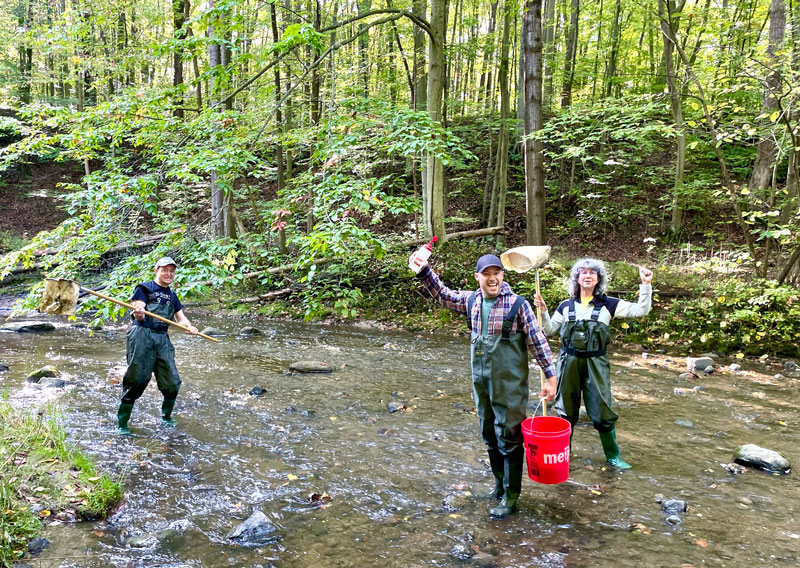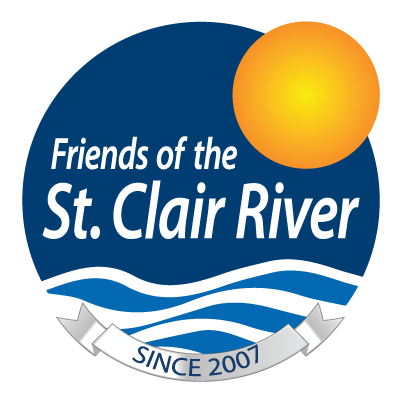PINE RIVER
WATERSHED
About the Pine River Watershed
Jump to Section:
Watershed Location and Size
The Pine River is the only watershed found completely in St. Clair County. It flows across 216 mi2 of land through the towns of Emmett, Goodells, and Smiths Creek before finally flowing in the St. Clair River in St. Clair, MI.
Watershed Wildlife
With its mix of agriculture and second-growth forests, a variety of wildlife is found in this watershed including deer, turkeys, pheasants, coyote, fox, songbirds, birds of prey, and many pollinating insects. You never know what’s going to show up around the river bend!

Male eastern bluebird
Watershed History
Prior to European settlement, the forests along the Pine River watershed offered a plethora of fish and game, wild fruits, and herbs. However, in the early 1800s, the landscape began changing as settlers cleared the pine and oak forests for logging industries. As the forests disappeared, much of the land transitioned to agricultural purposes. Businesses, industries, and residential housing developed near the mouth of the St. Clair River, and the City of St. Clair was established.
DO YOU HAVE A HISTORIC PHOTO?
Pine River Watershed Health
Water Monitoring
We learn a lot about the water quality of the Pine River from the organisms that live in it. Benthic macroinvertebrates (bugs that live on the river bottom) can indicate whether the water body is healthy or polluted. Friends of the St. Clair River regularly monitors benthic macroinvertebrates in the Pine River in our semi-annual Stream Team excursions. Current monitoring suggests that the Pine River is considered to have good water quality in the northern portion of the watershed.

Volunteers leading the way monitoring the Pine River.
Successes
- Rain gardens are showing up around the City of St. Clair. Such green infrastructure helps capture and clean stormwater runoff before it reaches the Pine River.
- Conservation programs exist for landowners to partner with federal, state, and local agencies to preserve and enhance riparian buffers adjacent to streams the flow directly into the Pine River to control agricultural runoff.
- Current research is focusing on using controlled drainage to reduce phosphorus loss from agricultural fields, protecting both a farmer’s investment and the watershed.
Challenges
- Failing septic systems are a major contributing factor for excess nutrient and bacteria loads into the Pine River, which ultimately flows to the St. Clair River.
- Runoff from excess fertilizer and other lawn and field chemicals contribute to nutrient loading in the river. Chemicals that help grass grow also help algae grow, which contributes to algae blooms.
Action
- Maintaining green infrastructure including rain gardens or buffer strips containing native vegetation helps capture lawn and field chemicals, control erosion, and stabilize riverbanks.
- Ensure your septic system is working properly. Regularly maintenance will prevent costly replacements and smelly consequences.
Pine River Watershed Recreation
Recreation
The Pine River offers a variety of recreational opportunities for all ages. The following are some local favorites:
- Kayaking, canoeing, and paddleboarding are popular water sports along the wide and quiet Pine River.
- The Pine River offers a host of family-friendly fishing opportunities including panfish and bass.
- Goodells County Park sits along the Pine River and offers a tremendous array of public activities throughout the year, including hiking, mountain biking, a BMX track, and the annual St. Clair County 4H Fair.
- The Pine River Nature Center is a great location to hike along the Pine River and learn about our local plants and wildlife.

Watershed Management Plan
The Pine River does not yet have a watershed management plan. Current discussions between multiple partners and stakeholders are taking place to raise funds for the research and development of a Pine River Watershed Management Plan.


